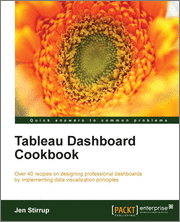DISCLAIMER
I received this book through the O'Reilly blogger review program, which I already mentioned in the review of Thinking With Data. The actual publisher of the book is Packt Publishing, not O'Reilly itself.
TABLEAU DASHBOARD COOKBOOK
I guess most people who have been in contact with the SQL Server community have at least heard of Jen Stirrup (blog | twitter): she currently holds the PASS board seat for Europe, she has spoken at dozens of different events and has won the PASSion award in 2012. I have watched her speak at the SQL Server Days in Belgium a few times before and this year she will deliver a full precon about Power BI and R.
Let's say I was a little bit excited when I heard she wrote a book about Tableau. I had no experience whatsoever with Tableau, but I had seen some demos and visualizations so I was anxious to try out the product. I got myself the book and I downloaded the free trial of Tableau Desktop 8.2.
Note: the trial is only 10 days, so if you want to finish the entire book in that time period, you better reserve some quality reading time for yourself.
Let's start with the good stuff. Personally I loved this book and the main reason is because it is very hands-on: there are a lot of examples (or recipes if you follow the cookbook doctrine) that guide you step-by-step through the features of Tableau. For readers inexperienced with Tableau – such as myself – this is a great way to discover the product without being overwhelmed by its many features. Each recipe starts with a short introduction – not too long so it doesn't get tedious – and then dives directly into the action. At the end there is a small recap of what you just did and how it works and there are optionally some pointers to further references. The book is limited on theory but overloaded with practicalities, which was very appealing to me. I felt I learned a great deal about Tableau by reading this book, but I also realized I just learned the basic functionalities of the product. That's why this book may not be suited for already advanced users of Tableau; they may not find a lot of new information in this book.
A small disadvantage is that this book is (in theory) already outdated because it deals with Tableau 8.1, while the 8.2 version has just been released. However, I didn't experience much difficulties over this. The only obvious difference is the import of multiple files, where there is now a much more graphical and easier to use interface to join tables together.
Personally I found that this book is best read from front to back, as the recipes in a single chapter often depend on each other: you start with a blank worksheet and in each recipe you build on top of the other until you end with a working dashboard at the end of the chapter. Also, sometimes chapters depend on the finished dashboard of the previous chapter. This makes it a bit harder to just jump to a chapter in the book and do some recipes. Luckily you can download finished worksheets from the publishers' website.
What I found a little bit disappointing was the section in the final chapter about R, called Wrapping up with R – dashboards as a tool. I have been toying with the R language lately and I expected to see some cool stuff there. But there was only an introduction on how to install R with a package called Rserve and how to set-up a connection from within Tableau to Rserver. That's it. No demonstration on how to actually use R with Tableau. I would have liked some more material over there, or maybe something in an addendum. An idea perhaps for a second edition? Anyway, this book is not about R but about Tableau 🙂
Now on to the bad stuff. Quite early on in the book – somewhere in chapter 2 – it became very clear that this book was badly edited. There are no spelling or grammar mistakes – not that I know of – but sometimes screenshots are switched or even wrong. One time a recipe – which is essentially a bulleted list of action points – jumped to the end while skipping a few steps. Sometimes when following the recipe step-by-step, you achieve a different result than what is displayed in a screenshot. Most of the time you can work around those issues by using your mind a bit and by comparing with (hopefully correct) screenshots. It can get annoying after a while, but it didn't stop me from reading the book (unlike some delicate little flowers who wrote some reviews on Amazon) because there is still very great content inside it. But you would think that with 4 reviewers, 3 proofreaders and 10 (!) editors mistakes like these would have been avoided. I have contacted the author and she told me that the mistakes have been reported and should appear on the Errata page.
All in all, I recommend this book to people new to Tableau. They will definitely learn enough by this book to take their first steps with Tableau. A job well done by the author, but shame on you Packt Publishing for all those mistakes. Fire those editors please.
UPDATE: the author (Jen Stirup) has placed errata about chapter 2 on her blog.






